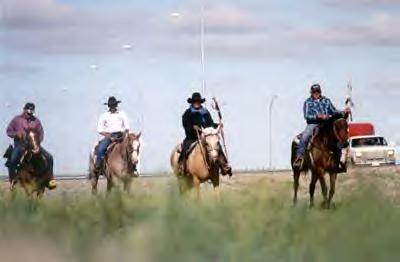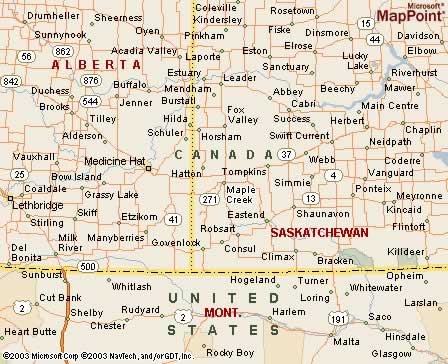|
|
Canku Ota |
|
|
(Many Paths) |
||
|
An Online Newsletter Celebrating Native America |
||
|
August 9, 2003 - Issue 93 |
||
|
|
||
|
Unity Ride Completes Prairie Leg |
||
|
by Matt Ross
Indian Country Today
|
||
|
credits: Photo
1-Clayton Cyr Jr. (purple shirt), Clayton Cyr Sr. (white shirt),
Lawrence Patrick (black jacket) and Wilfred Tom (checkered shirt)
travel together during this year's Unity Ride. Photo 2-No duties
are too small for Unity Ride's organizer Eric Mitchell. (Photos
by Matt Ross)
|
|
But for all of the physical aches of continuous horseback riding along with the mental strains of teamwork and camp uniformity, organizers and participants swear the cause is greater than any individual's minor suffering. Especially when it's the youth who can witness Native pride in motion, that's why the end justifies the means. For the last three years, Eric Mitchell of the Okanagan Reserve in central British Columbia has been a host of this sacred journey throughout Canada. Starting June 2, he and his fellow travelers have galloped eastward across the prairies linking up with numerous bands retracing the steps of their ancestors in the heartland of the continent. Unity Rides began in 1986 when the Lakota elders of North and South Dakota were guided to regain the spirit of their nation that had been broken since Wounded Knee. Although Canadian history doesn't have any one defining moment such as this massacre, Indians north of the border nonetheless have suffered enough despair and poverty. That's why Mitchell's group will have been on the road for seven weeks covering 1,200 miles from Vernon, British Columbia, to their finish on July 18 in Sioux Valley, Manitoba. Ideally for those who they meet, this encounter can serve as a time of reflection and to take an active role toward change. "By riding horses and making this an exciting journey, it's to inspire First Nations communities to want to create for themselves a more suitable life for the next 500 years," Mitchell said. In order to accomplish the ride, Mitchell is joined by a cadre of family and ride participants numbering about a dozen. The total number within the traveling party fluctuates however as the ride picks up new participants for a couple of days while saying goodbye to others along the road.
"To hear the stories, I fell in love (with the idea) and wanted to be here. There would be struggles and ups and downs but I wanted to respect my nation and be a role model for the youth and young women," she said. As Patrick, Mitchell and the rest of the crew combine riding with sharing the daily activities such as preparing meals and setting up camp, one of the participants is completing his own marathon as he attempts to become the only member to ride the entire distance. Wilfred Tom from Douglas Lake, British Columbia and also of the Okanagan Nation operates his own ranch so horses are second nature to him. Yet, by deciding to join the Ride only two days before its departure didn't give him much time to prepare for the daily 30-50 mile segments. The oldest of the participants, Tom is 69. "To carry the (men's) staff is an honor because it represents not just my people back home but all nations. At times whether I'm hurting or in pain, I'm not doing this for myself but for the women, children and grandchildren I've come across," Tom pointed out. What prompts the immediate success of a Unity Ride is the magnificence of horses trotting along the highway. Besides the natural curiosity and well-wishes of the public, when a party consisting of five horses and a half-dozen vans pulls into a reserve, the riders are usually accorded dignitary status. That's why it would be natural for the participants to act as ambassadors in promoting Native history and traditions. "The children were excited because we were camped just off their playground," Patrick said about one of the first nights in Creston, British Columbia where they were requested to address the local elementary school. "'What do you do?' was what we were asked and I said 'Think of it like a two-month camping trip but riding horses every day.'" Departing in the early morning the crew will have been up for several hours beforehand, especially Tom who feeds and waters the animals around 5 a.m. Gathering around the center of the camp where the eagle feather staffs are stationed some encouraging words are spoken by the elders as the horses and riders are smudged with the sweet-smelling smoke of sage. "We carry these by horse and foot to show the youth that our traditional ways of doing things and philosophies are as valid today as in the past," Mitchell explained about the significance of the staffs. The ride attempts to log as many miles as possible before the heat of the day when it's necessary for both the horses and riders to break for lunch. On this day outside of Maple Creek in southwestern Saskatchewan, two members of the Pasqua First Nation (east of Regina) joined. In order to give the original five horses a rest, two of which were being broken in, and to make up for some lost time, Clayton Cyr Sr. and Clayton Jr. brought an additional six horses to use as the tour passed through the province. This generosity was just one example of what has been donated to the Ride by the numerous reserves. Before embarking, Mitchell contacted several of the nations so they could be accommodated with a campground and access to water for the horses. Not only were such favors met but also continuously offered by Natives and non-Natives. Donations of money and food, for animal and man, and spontaneous assistance showing the message of unity were also received. The honor of riding by horseback throughout the countryside, even if the trek is adjacent to the Trans-Canada Highway, is majestic but also exhausting. Water breaks set up by other crewmembers that have driven ahead provide welcome relief every half-hour when the summer sun beats down mercilessly. Once the ride ends, it will have been the elder Tom who has subjected his body to the most on the ride. While the intrinsic value of seeing western Canada by horseback will have a lasting impression, he will have spent more than 200 hours riding, an activity that easily hampers his already stiff back. On a rest break Tom was asked what keeps him going and how he maintain mental sharpness through all of the trotting. "As I ride, I pray. I pray for the horses, the other riders and Mother Earth. I pray also for the other nations that one day we can all come together as one nation," said Tom on what he contemplates when riding. The completion of this year's ride marks only the halfway point of what is a two-year process. Next summer, the team will return to Manitoba and continue for two months until they reach the opening of the International Elders Summit hosted by the Six Nations of the Grand River Territory in southern Ontario in August 2004. |
|
|
www.expedia.com |
|
|
||
|
|
||
| Canku Ota is a free Newsletter celebrating Native America, its traditions and accomplishments . We do not provide subscriber or visitor names to anyone. Some articles presented in Canku Ota may contain copyright material. We have received appropriate permissions for republishing any articles. Material appearing here is distributed without profit or monetary gain to those who have expressed an interest. This is in accordance with Title 17 U.S.C. Section 107. | ||
|
Canku Ota is a copyright © 2000, 2001, 2002, 2003 of Vicki Lockard and Paul Barry. |
||
 |
 |
|
|
The "Canku Ota - A Newsletter Celebrating Native America" web site and its design is the |
||
|
Copyright © 1999, 2000, 2001, 2002, 2003 of Paul C. Barry. |
||
|
All Rights Reserved. |
||
 MAPLE
CREEK, Saskatchewan - As mile after mile grinds on, the novelty
of a Unity Ride begins to dissipate when the scenery changes ever
so slowly. The initial euphoria dwindles once days merge into
weeks and this cross-country trek becomes a test of patience and
endurance.
MAPLE
CREEK, Saskatchewan - As mile after mile grinds on, the novelty
of a Unity Ride begins to dissipate when the scenery changes ever
so slowly. The initial euphoria dwindles once days merge into
weeks and this cross-country trek becomes a test of patience and
endurance.  Two
of those who have accompanied Mitchell from June also seek their
own fulfillment for spending almost two months on the ride. Sylvia
Patrick from the Stl'atl'imx Nation in Pemberton, British Columbia
(two hours north of Vancouver) gave notice at her job as a secretary
for a health board once she heard about the ride and after meeting
Mitchell.
Two
of those who have accompanied Mitchell from June also seek their
own fulfillment for spending almost two months on the ride. Sylvia
Patrick from the Stl'atl'imx Nation in Pemberton, British Columbia
(two hours north of Vancouver) gave notice at her job as a secretary
for a health board once she heard about the ride and after meeting
Mitchell.